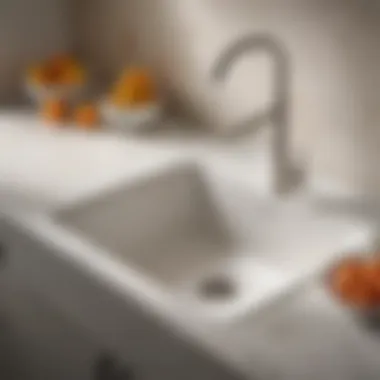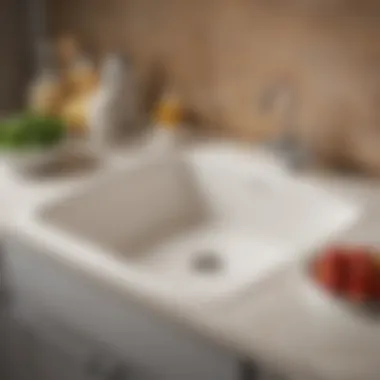Understanding and Managing Blanco Sink Stains Effectively


Intro
Maintaining the aesthetic integrity of a Blanco sink, known for its durability and distinctive appeal, can pose various challenges, particularly when it comes to stains. Stains can arise from everyday kitchen activities, and they might often be a source of frustration for homeowners and culinary enthusiasts alike. A clear understanding of these stains is paramount in crafting an effective strategy for their prevention and removal.
The Blanco sink's engineered surface can be susceptible to discoloration and marks, especially when in contact with certain substances. Identifying the most common culprits and developing informed cleaning methods is critical. This article aims to demystify the nature of stains on Blanco sinks and arm readers with practical tips for upkeep.
Common Staking Substances
There are several common substances that tend to stain Blanco sinks:
- Coffee
- Tea
- Fruit juices
- Red wine
- Tomato-based sauces
- Hard water deposits
Each of these has characteristics that can lead to discoloration or dinginess if not treated promptly. Understanding these substances’ traits is crucial in preventive measures.
Prevention Techniques
The best way to handle stains is to prevent them in the first place. Here are practical tips to consider:
- Immediate Cleanup: Wipe away spills as they happen.
- Use of Trivets and Coasters: Prevent direct contact for items likely to stain.
- Regular Cleaning: Incorporating a routine cleaning schedule can reduce the accumulation of grime.
Adopting these practices can prolong the sink's pristine condition significantly.
Effective Removal Strategies
If stains do occur, effectively removing them can be accomplished through different methods:
- Mild Cleaners: Using soft sponges and liquid detergents generally suffices for daily maintenance.
- Baking Soda Paste: For stubborn stains, a paste of baking soda and water can be very effective.
- Vinegar Solution: A mixture of vinegar and warm water can help dissolve limescale and stains from hard water.
A worn-out sponge may scratch the surface; picking a gentle scrubber is important for preserving the sink’s material integrity.
Maintain Pristine Appearance Over Time
To keep your Blanco sink looking new over time, avoid abrasive cleaners or those containing bleach. Instead, choose products specifically made for composite surfaces. Staying proactive and utilizing the methods described can ensure that your Blanco sink remains not only functional but visually appealing.
Understanding the possible threats and applying the right actions can reduce stress regarding maintenance. With insight and diligence, even challenging stains can be kept at bay.
Prelims to Blanco Sinks
Blanco sinks have grown in popularity among homeowners and culinary enthusiasts. They combine aesthetics with functionality in kitchens. The importance of this section lies in understanding what sets Blanco sinks apart, especially in relation to staining and maintenance. Blanco sinks are known for their durable surface, but they also require knowledge about what they are made from and how to care for them effectively. This knowledge can prolong their lifespan and maintain their attractive appearance.
Material Composition
The composition of Blanco sinks largely influences their performance and how they react to stains. Made from a unique blend of composite materials, Blanco sinks stand out for their resistance to scratches and chips. The most common material is a combination of acrylic resins and natural stone. This mixture ensures durability while allowing for various designs and colors. The surface is usually nonporous, which means it does not absorb moisture, helping to resist stains to an extent. However, this feature must be paired with appropriate cleaning techniques to keep the surface looking new.
Popular Models and Features
Blanco offers a range of sink models, catering to various styles and culinary preferences. The most notable models include the Blanco Precis, Blanco Super, and Blanco Diamond. Each model showcases different features, such as sound-deadening technology and easy-to-clean surfaces. The intricate designs not only add to visual appeal but also enhance your kitchen's functionality. These sinks are available in multiple colors and finishes, allowing homeowners to match them seamlessly with existing decor. Understanding these models aids in making an informed choice that balances personal preference with practical needs.
Common Types of Stains on Blanco Sinks
Understanding the common types of stains that can afflict Blanco sinks is essential for homeowners seeking to maintain their aesthetics and functionality. Blanco sinks, made from durable composite material, can encounter various staining agents from everyday use. Identifying these stains not only aids in their removal but also in managing their permanence over time. Knowing the sources of stains leads to better preventative care and preserves the longevity of the sink. Homeowners can enjoy their culinary experience without the distraction of unappealing marks.
Organic and Food Stains


Organic stains usually accumulate from food residue. Common sources include tomato sauce, wine, coffee, and many others. The porous nature of some Blanco sinks can allow these substances to settle in more deeply than desired. If not attended to swiftly, these organic stains can become stubborn. To address these stains, act quickly by rinsing off spills immediately, thus restricting ingrained elements.
To remove organic stains effectively:
- Dine carefully to minimize spills, especially with potent substances like red wine.
- Use a gentle cleanser designed for composites and a soft sponge later.
- Surface scrubbing can help if stains persist, applying only energy to stain-clustered areas.
In summary, timely action is crucial to prevent food-based discoloration.
Chemical and Hard Water Deposits
Chemical stains emerge primarily from cleaning products while hard water stains result from mineral buildup. Blanco sinks are not immune to these challenges. Cleaning agents can react negatively with your sink's surface, leading to unusual marks.
On the other hand, hard water deposits create unsightly layering that diminishes the brightness of the Blanco finish. To tackle these issues effectively, regular maintenance practices should include:
- Regular rinsing of the sink after washing away chemical agents.
- Utilizing vinegar for safe descaling if hard water impurities arise.
- Avoiding harsh abrasives since they can damage the surface condition.
Environmental Stains
Environmental stains usually stem from external factors, including smoke, pollution, or even rust from fixtures nearby. External conditions like humidity can play a role too, causing materials to degrade over time. These stains can present a challenge quite different from food or chemical marks, often requiring special attention.
To prevent and manage such environmental stains, consider these points:
- Ensure ventilation in areas with abnormally high concentrations of smoke or soot.
- Wipe down your sink frequently to avoid the buildup of environmental considerations.
- Inspect surrounding fixtures for rust, correcting any issues preemptively.
Identifying Stains on Blanco Sinks
Identifying stains on Blanco sinks is critical to maintaining their aesthetic appeal and longevity. Many homeowners may overlook the nuances of the stains that appear on their sinks. However, understanding how to spot them can save time and effort in cleaning and upkeep. Additionally, early detection allows for more efficient removal strategies to be employed—minimizing damage and prolonging the life of the sink.
Visual Indicators of Common Stains
There are several visual indicators to look for when identifying stains on Blanco sinks. Each stain type may present itself in specific ways:
- Organic Stains: Residual food particles or beverage spills tend to leave darker spots, commonly around the seams or near the drain.
- Chemical Stains: These can form from the use of harsh cleaning agents. A dull discoloration might indicate chemical damage.
- Hard Water Deposits: Mineral build-up presents as white or cloudy patches on the sink surface. Paying close attention to the faucet and edges can reveal this.
Besides these markers, it is also beneficial to conduct periodic inspections of the sink surface under different lighting conditions. This practice might expose stains otherwise unnoticed. Gathering this awareness is essential in curative measures.
Differentiating Between Stain Types
Distinguishing between various stain types is essential for effective cleaning. Each stain has unique characteristics and removal requires specific methods:
- Food Stains: Usually organic, appear from residues left by fruits, vegetables, acids from vinegar, or wine.
- Chemical Stains: Result from improperly used cleaning products that can etch apart the sink’s surface. Caution is needed here, as the damage might not always be immediately visible.
- Environmental Stains: These can originate from airborne particles, which may settle and interact with water, leading to visible changes.
Knowing the difference can guide the choice of cleaning products and methods. Coupled with vigilant observation, a well-informed homeowner can act swiftly, ensuring the Blanco sink remains in optimal condition for years to come.
"Prompt detection of stains leads to lower long-term maintenance costs and enhances the overall utility of the sink."
Impact of Stains on Blanco Sinks
The impact of stains on Blanco sinks is a crucial section to discuss. Blanco sinks, made from resilient composite materials, are designed for longevity and aesthetic appeal. However, stains can compromise their visual and practical benefits. Understanding these impacts helps homeowners grasp the significance of regular maintenance and effective stain prevention.
Aesthetic Concerns
When it comes to aesthetic value, stains on a Blanco sink can be detrimental. An immaculate sink enhances the overall beauty of a kitchen. Stains disrupt that visual harmony, drawing attention and making the space appear less inviting. Homeowners may notice discoloration from tea, coffee, or red wine, which can settle into the surface if not promptly cleaned. The biocomposite material is designed to resist scratches, yet stains can still mar its look. Because kitchens are often social spaces, this aesthetic deterioration could lead to embarrassment or reluctance to entertain guests.


In addition to immediate visibility, some stains show a change in color or texture that could be more difficult to remove over time. Regular cleaning mitigates this risk, preserving not only the sink but also the entire kitchen’s visual quality.
To maintain the pristine appearance of your Blanco sink, consider the following:
- Immediate Cleaning: Address stains right after they occur.
- Choosing Safe Products: Use cleaning agents that are gentle to avoid scratching.
- Avoiding Colorants: Avoid staining substances when possible.
Functional Implications
Stains also carry functional implications that affect the usability of a Blanco sink. A sink is not just an aesthetic element; it serves an essential role in any kitchen. Food residue, waterways, and chemical deposits accumulate as organic stains develop. Over time, this buildup can impede drainage and promote bacteria growth. Residual bacteria may pose health risks and, ultimately, affect your cooking.
Moreover, repeated exposure to hard water can result in calcification deposits that hinder the sink’s functionality. If not addressed, this could lead to more severe plumbing issues, locking out easy removal of limescale and requiring professional intervention. Here are practical tips to safeguard functionality:
- Educate Household Members: Ensure everyone handles the sink correctly; miscellaneous use can result in unintended stains.
- Regular Maintenance Checks: Schedule time to inspect for issues before they escalate.
- Use of Protective Measures: Employ sink liners to further ensure degradation does not worsen over time.
Effective care for Blanco sinks is not a side task; it is essential for reliable kitchen operation. Maintaining both the appearance and functionality demands diligence.
Preventative Measures for Stain Management
Effective stain management is crucial for preserving the natural beauty and functionality of Blanco sinks. By implementing preventative measures, homeowners can combat stains before they become permanent fixtures. Prevention not only safeguards the investment you have made in your sink but also reduces maintenance time and costs. Understanding effective strategies is vital in ensuring your Blanco sink withstands the wear and tear of daily use.
Regular Cleaning Routines
Establishing a regular cleaning routine is an elemental strategy in stain management for Blanco sinks. Frequent cleaning minimizes residue buildup from food particles, soap, and minerals within water.
To create an effective routine:
- Schedule cleaning tasks according to your kitchen usage. Daily or weekly cleanings can help eliminate stains in their infancy.
- Use a soft cloth or sponge with warm water and mild dish soap to clean the sink; avoid abrasive materials that could damage the surface.
- Rinse thoroughly to remove residue and dry with a soft towel to prevent water spots.
Following this routine will prove to be beneficial in maintaining the visually appealing surface of the sink.
Using Protective Liners
In addition to regular cleaning, utilizing protective liners is another effective method to reduce the occurrence of stains. Protective liners can act as a barrier against food spills and stains, especially for activities such as food prep.
Consider these points when choosing protective liners:
- Select materials that are non-toxic and safe for kitchen use. Rubber or silicone options are widely available.
- Ensure the liner fits snugly within the sink so it doesn’t become a tripping hazard during use.
- Clean liners frequently to prevent build-up and potential odor.
Incorporating protective liners can provide a swift solution to avoid stains while catering.
Avoiding Harsh Chemicals
Awareness regarding the cleaning agents used on Blanco sinks is essential. Many harsh chemicals and abrasive cleaners can strip the finish and lead to permanent damage. Hence, avoiding these substances is paramount for stain prevention.
Understand the types of products to avoid:
- Avoid bleach and ammonia-based cleaners, which can corrode the materials over time.
- Do not use abrasive powders, steel wool, or scouring pads.
Instead, opt for reputable cleaning solutions specifically designed for such surfaces.
Remember to always refer to the manufacturer’s instructions to Elect the best products for cleaning without causing wear.
"A proactive approach to cleaning and maintenance can significantly prolong the life of a Blanco sink."


Implementing these preventative measures can effectively manage stains while ensuring the ongoing aesthetics of your sink. Awareness of cleaning agents, protective measures, alongside maintaining an efficient cleaning routine constitutes a sound strategy to uphold the integrity of Blanco sinks.
Effective Cleaning Techniques
Cleaning is not just about achieving a visual appeal but also about preserving the integrity and functionality of your Blanco sink. Effective cleaning techniques can mitigate the build-up of stains, contribute to a more hygienic kitchen environment, and extend the life of your sink. Understanding proper cleaning methods is essential for both aesthetic and practical reasons.
Recommended Cleaning Products
Choosing the right cleaning product can have a significant impact on how effective your cleaning efforts will be. It is important to select products specifically formulated for composite sinks. The following are key recommendations:
- Gentle dish soap: This is safe for most surfaces and can effectively remove light dirt and grime.
- Baking soda: An excellent abrasive that can help tackle more stubborn stains without scratching the surface.
- White vinegar: Useful for its acidity, which cuts through mineral deposits and disinfects.
- Blanco cleaning cream: A specialized product designed by Blanco for their sinks, ensuring compatibility and effectiveness.
When selecting cleaning products, avoid any harsh cleaners, like bleach or ammonia, which can damage the sink’s surface over time.
Step-by-Step Cleaning Process
A systematic approach to cleaning ensures thoroughness and efficiency. Here is a step-by-step guide to cleaning your Blanco sink:
- Rinse the Sink: Begin by rinsing the sink with warm water to remove loose debris.
- Apply Cleaning Product: Use gentle dish soap or a specially formulated Blanco product.
- Scrub Gently: Utilize a soft cloth or sponge. Apply mild pressure to avoid scratching.
- Target Stains: For tougher stains, sprinkle baking soda directly onto the stained area and scrub gently.
- Rinse Thoroughly: Make sure to remove all cleaning product residues.
- Dry the Surface: Wipe the sink dry with a microfiber cloth to prevent water spots.
Always test any new cleaning product on an inconspicuous area before full application to ensure compatibility.
Following this method minimizes the risk of damage and maintains the sink's pristine look, keeping it functional for culinary duties.
Long-term Maintenance of Blanco Sinks
Maintaining the integrity of your Blanco sink over the long term is critical for both functionality and aesthetics. This article's section on long-term maintenance emphasizes methods for keeping your sink in optimal condition while avoiding stains and blemishes that can diminish its appeal. Longevity of a Blanco sink relies significantly on regular care and attention. With appropriate maintenance practices, homeowners can ensure their investment remains durable and visually-pleasing for years to come.
Routine Inspections and Repairs
Regular inspections can reveal areas that need urgent attention. This is a proactive measure in maintaining your Blanco sink. Observing small cracks or faded spots can prevent larger issues in the future. Schedule these inspections at least twice a year; more frequent checks might consider mounting tasks that would otherwise lead to frustrating repairs later.
- Checking for Cracks: Examine the sink thoroughly for any signs of cracking or fading in color. These markings can indicate overexposure to heat or chemicals.
- Inspecting Seals: The seals around your Blanco sink are susceptible to wear, often allowing moisture retention. Pay attention to these points, as neglected seals can lead to long-term damage.
- Cleaning During Inspections: Incorporate your cleaning routine with inspections. This means not only looking for stains but also assessing the sink for coverage in unwanted grime.
For less serious issues, such as minor discoloration, it’s usually enough to treat small stains without needing professional repairs. However, once you start detecting noticeable damage, consulting a professional may be essential to preventing future problems.
Best Practices for Longevity
Adopting best practices guarantees the shininess and functionality of your Blanco sink withstand time and usage. Here are several practices to prevent wear:
- Gentle Cleaning: Use soft cloths and non-abrasive cleaners to minimize scratching and preserve surface quality. Consider brands like Soft Scrub or Bar Keepers Friend for cleaning their suitability on composite materials.
- Avoiding Heat Damage: Take care where you place hot pots and pans. A regular practice of using trivets or cool mats can save you from unwanted surface alterations.
- Immediate Attention to Spills: React promptly to any acidic liquids like vinegar or lemon juice finding their way onto your sink's surface. Quick mishandling can lead to staining and etching, affecting aesthetic value.
- Routine Application of Sealants: Consider applying sealants to add a layer of protection against stains and wear. Ensure that the sealants used are recommended for composite sinks.
- Using Drain Protectors: They can trap food and debris that may lead to persistent stains, keeping the sink system clearer and easier to maintain.
Keeping up with these practices will pay off in terms of not just maintenance but also the overall visual appeal and durability of your Blanco sink. It can significantly extend its lifespan and sustain a pristine look, enhancing your kitchen's beauty continuously.
Long-term maintenance is more than just cleaning; it’s a comprehensive approach to nurturing your Blanco sink. With consistent attention and well-implemented techniques, your sink will not merely survive but thrive.
Finale
Recap of Stain Management Strategies
Managing stains on Blanco sinks relies on combining several strategies tailored to specific types of stains. Here’s a concise list
- Cleaning Routines: Establish a regular cleaning schedule using non-abrasive cleaners designed for composite stone sinks. Daily maintenance prevents buildup from various substances, extending the product's lifespan and shine.
- Protective Liners: Consider using sink mats or liners to protect the surface from heavy cookware and sharp objects that might cause scratches.
- Avoid Harsh Chemicals: Steer clear of using bleach or highly acidic cleaners as they can cause discoloration and degrade the sink’s surface.
- Immediate Treatment: Address spills promptly to prevent staining, particularly with brightly colored food or vino.
Encouragement for Proactive Care
Taking proactive measures in care and maintenance of Blanco sinks can dramatically improve their lifespan and functionality. This could include:
- Conducting regular inspections for any signs of wear or staining, allowing for timely resolutions before issues escalate.
- Utilize recent products in sink care that offer higher performance when dealing with stains.
- Awareness of environmental factors, such as the water quality in the area, which may impact staining potential. Just remembering these tips will ensure owners maintain their Blanco sinks effectively.
Every action to understand stains and apply proper care plays a role in user experience. Stay informed and ahead to enjoy the full benefits these sinks have to offer.







